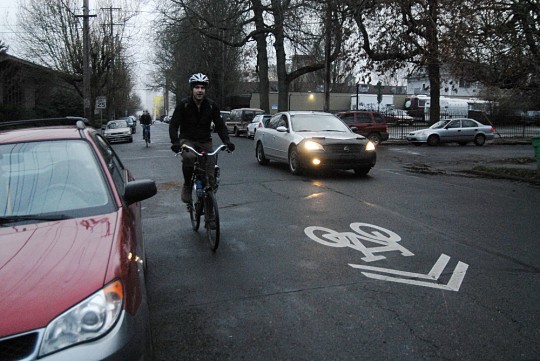
(Photo: M.Andersen/BikePortland)
One of the city’s first bike boulevards may be on its way to a quick upgrade.
Southeast Ankeny Street would get additional speed bumps and a new diagonal traffic diverter at 15th under a plan advanced by advocacy group BikeLoudPDX, endorsed by Portland Bicycle Planning Coordinator Roger Geller and tentatively backed by the Buckman Community Association.
The plan came together quickly this fall after Buckman-area residents who are active in BikeLoudPDX set a goal of winning BCA’s endorsement of a new traffic diverter between 12th and 20th avenues. Restricting traffic in that stretch would prevent people from driving on Ankeny to avoid the Burnside-Couch couplet during the morning rush hour.
“In the morning rush hour, if you stand at the intersection of 16th and Ankeny, not far from Buckman Elementary, you’ll see lots of cars whipping a left turn off Burnside, often at a high rate of speed,” wrote Chris Shaffer, a BikeLoud advocate and Buckman homeowner, in a September email to the BCA explaining the problem. “They turn right on Ankeny westbound, heading toward Sandy Boulevard or 11th and points south.”
With the help of letters like Shaffer’s, another BikeLoud advocate and local resident, Soren Impey, secured a spot on the BCA’s agenda that month and presented city traffic data that showed the problem.
Impey, who works as a professor at Oregon Health and Science University, said there was “some skepticism” at first by some BCA board members, but that the BCA board also includes some biking advocates and many who worry about safety on Ankeny in general.
Skepticism seemed to dissipate, Impey said, once residents saw that city data showed rising traffic even before this year’s removal of a westbound travel lane on East Burnside in order to reduce crashes there.
The following month, Geller (who is himself a Buckman resident) attended the BCA meeting with more data. Below are some of the charts Geller presented.
Here are two that compare traffic on patterns on Ankeny in 1997 and 2013. Note the pink line that represents westbound traffic east of 14th — there’s been a huge spike during the morning rush hour, just as Shaffer described.
Advertisement
Here’s a chart of which road segments see the most cars and trucks (here described as vehicles per day or VPD):
And here’s how fast they’re moving at the 85th percentile (in other words, 15 percent of cars are moving faster than these speeds):
Geller said the street is currently engineered to be driven at 25 mph. Adding a few more speed bumps would bring this down to 20 mph.
A person hit by a car that’s moving at 30 mph has a 40 percent chance of dying. At 20 mph, that falls to 5 percent.
In the morning rush hour on Ankeny at 15th, 80 percent of all westbound vehicles in October 2014 were bicycles. For the full day, the figure is 68 percent. Among Buckman residents, about one in five workers commutes by bike, according to the U.S. Census.
After Geller’s presentation, the BCA wrote him a letter saying that traffic volumes and speeds are both “too high” on parts of the Ankeny greenway. BCA endorsed “advancing the idea” of a diverter at 15th and Ankeny so long as the city conducts adequate outreach to neighbors and businesses.
Geller said Monday that a diverter-speed bump project would cost about $30,000 from the city’s general neighborhood greenway improvement fund and the city’s “missing links” capital improvement fund. In an email to Impey, he wrote that he expects to start working on the project in February and make the changes this spring.
The amount of outreach and planning required “depends on what we hear from the public,” Geller said Monday. “If people are generally supportive of what we’re doing it could be one meeting. If people are more concerned about things … it probably would take a couple months.”
It’s worth noting that this intersection becomes a major destination in its own right on one day of the week: Sunday. The southeast corner is the Imago Dei church, a thriving, young and relatively politically conservative congregation that (despite having been described on Beliefnet.com as “so cool, you’d think Jesus Himself shopped at American Apparel”) arrives overwhelmingly by car.
Impey said Tuesday that BikeLoud is planning to do its own outreach on the project, including to local businesses.
“It seems like pretty much if the public outreach is moderately favorable, it’s going to happen,” he said.
He hopes that if this work is completed by spring, it’ll serve as a test case for future neighborhood greenway upgrades that the city has begun to study.
If you’d like to get involved with BikeLoud’s effort, contact him: sorenimpey@gmail.com.
Impey said he was motivated by frustration with the failure of the 20s bikeway project to create a direct biking connection through his neighborhood’s main commercial node.
“I was just really annoyed with what happened with 28th, so I wanted to do something to help,” he said.

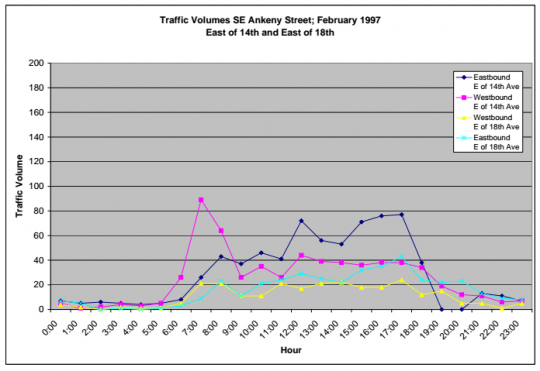
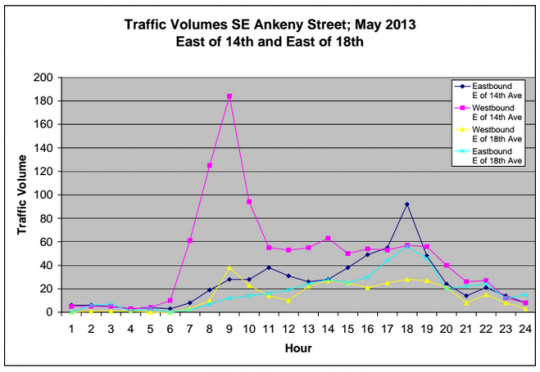
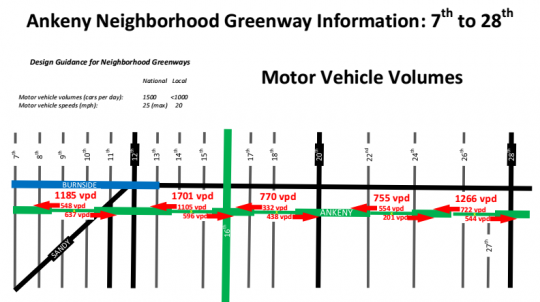
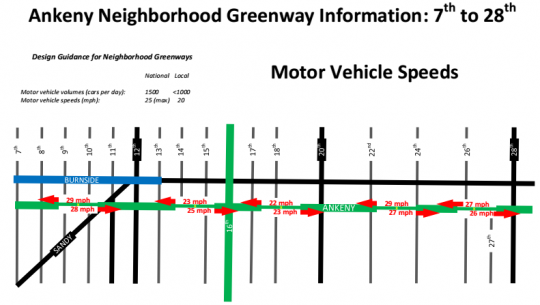

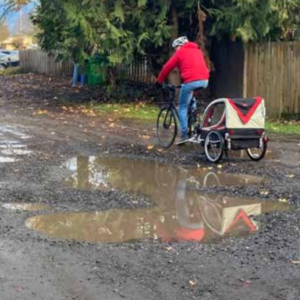
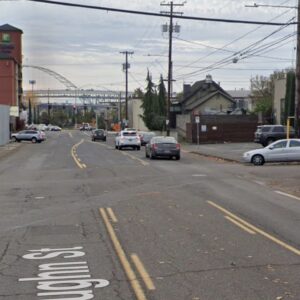
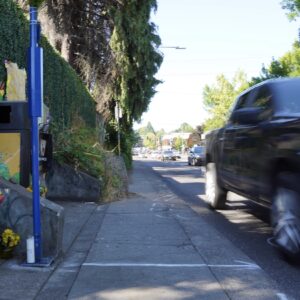
Thanks for reading.
BikePortland has served this community with independent community journalism since 2005. We rely on subscriptions from readers like you to survive. Your financial support is vital in keeping this valuable resource alive and well.
Please subscribe today to strengthen and expand our work.
<>
Typo, no? Slower speed = better chance of survival!
Sorry, looks like I goofed on the formatting. Here’s the text I was referring to:
A person hit by a car that’s moving at 30 mph has a 40 percent chance of dying. At 20 mph, that rises to 95 percent.
The language is still wrong. I think you mean ‘surviving’.
Sorry about the probably eggnog-addled prose, folks. Thanks for the corrections – fixed.
Enjoy that eggnog yo!
The two studies cited in the hyperlink on speed versus mortality are, ummm…. (how to say this delicately?) …deeply flawed. I would really hate to see those studies quoted in an effort to support speed limit reduction as a means of reducing pedestrian fatalities. Because it would not take a sharp opponent much time and effort to debunk those studies.
First, they are old (mid 90s). Secondly, the methodology is questionable at best. Third, mortality rates for just about everything injury-related have seen a sharp decline over the past 20 years, due to advances in medical care, resuscitations, etc. So the real death probabilities are likely much, much lower.
And, having read the entire second citation twice (Anderson, et al), nowhere do I find the figures cited by the hyperlink. Nowhere.
Not saying that there’s no direct relationship between car impact speed and pedestrian mortality (there clearly must be, given Newton’s laws of motion, etc). But I would never quote those numbers as anything more than outdated approximations based on second-hand data.
These are pretty widely cited numbers – here, for example, or here – but fair enough; I’m always glad to be called out for weak science. Here’s a chart that I’m told comes from this 2005 analysis; it’s cited on p. 15 of this 2008 report from the OECD’s International Transport Forum. According to that chart, it’s more like a 13 percent chance of death at 20 mph and an 80 percent chance of death at 30 mph.
I’d invite anyone else familiar with this research to weigh in on the best numbers to use – I’m sure someone here knows it well.
Michael, I’ve spent the last three hours trying to track down the original citations. The “Wramborg P.(2005)” data presented in Warsaw that is cited on p. 15 of the International Transport Forum Summary Document does not appear in any PubMed search that I tried, and I did try multiple permutations. Probably it was never published, only reported at the conference and then summarized in the document to which you linked. I suspect that it’s a case of dubious data being reported, cited, re-cited and finally taken as gospel. But review of the original paper by Anderson published in 1997 leaves me convinced that we really do not know what the actual mortality rates are for any given speed of impact (car v.s. pedestrian). I’m convinced that those authors never really knew what the mortality rates were either – they simply used ISS (Injury Severity Score) as a proxy for mortality. I can tell you that such an approach would not fly in today’s trauma/injury academic environment. Maybe that shouldn’t disqualify it as a legitimate tool in advocating for slower speeds, maybe it should – I don’t know.
Again, I am a firm believer that speed kills and that higher speeds kill more efficiently. But I shy away from quoting actual percentages and mortality probabilities because the data just isn’t there to support such numbers, and a clever opponent in a debate who spent only a few hours on the internet (like I did today) would make me look foolish by exposing the tenuous validity of my numbers. Maybe some day that study will be done, but until then…
Does it speak to our geek/nerdy/wonky pedantic nature that so many of us caught this,
It was the first comment,
And that there were enough of us here on 12/24 to give the author good natured ribbing over it?
For your pedantic enjoyment:
“Weird Al” Yankovic – Word Crimes: http://youtu.be/8Gv0H-vPoDc
Yes, I noticed the mistake and was about to mention it here.
YES YES YES! A diverter blocking traffic from making that right off 15th onto Snkeny is a MUST.
100% full support. Go BIKELOUDPDX! keep it coming.
Great example of collaboration! Is that a diverter for Clinton Street I see in the distance?
One of our goals is to gather data and resident/business testimonials so we can argue more strongly for diverters elsewhere.
Mike,
Does the city have any sketches of proposals? 😉
Speed bumps are not needed. The fire department doesn’t like them. Just add diverters.
Ankeny is not a major response route, so PF&R doesn’t mind them on Ankeny.
85th speeds are below 25 mph 12th to 20th, but above that 20th to 28th. A cyclist or pedestrian’s risk of death when struck at 20 mph is under 15%, but at 25 mph it doubles to 30% and at 30 mph it goes to over 75%. (Wramborg Graph)
Lower auto speed is key to making Portland’s neighborhood greenways the safest routes in the city.
The 29mph 85th percentile speed between 20th and 28th is unacceptable for a greenway. Speed bumps or more frequent diverters would do the trick, but speed bumps are a lot cheaper. The Fire trucks can use Burnside if they need to get somewhere quickly.
Hooray! Would this be similar to the diverter already in place at SE 20th?
As a regular SE Ankeny, SE 12th and SE 28th user this is a great step in the right direction.
Interesting Question – Would another Diverter just east of Universal Cycles be a possibility or one at SE 15th & Burnside?
The design for the diverter has not been finalized but the current proposal is to install a diagonal diverter:
http://nacto.org/wp-content/gallery/neighborhoodgreenway_volumemanagement_photos/diagonal-diverter-portland-or.jpg
More bikes = clean air. Carbon footprint of cycling one mile…
http://tinyurl.com/nkkdwl5
I applaud all the advocacy that has gone into the effort to make Ankeny safer. Keep it coming everyone!
One crossing that I see having room for improvement is the intersection of Ankeny and Sandy. It’s currently dreadful to cross as a bicyclist or pedestrian IMO. When heading westbound on Ankeny I currently avoid this intersection by turning right onto 12th. I then turn left onto either Couch or Davis.
Oh dear God yes this intersection is indeed in desperate need of help. It’s a disturbing experience every time. 🙁
Yes, but look at what they did at 9th and Sandy as part of that bioswale project. The north-south crossing on 9th is MUCH better, even though 9th has not been built out to bikeway/greenway standards yet at least they Were thinking ahead!
We also discussed this at the BCA. That part of Ankeny borders the Central Eastside Urban Renewal Area so hopefully there will be an opportunity to further improve lower Ankeny in the not to distant future!
“too distant”
So right after the Ankeny one is installed we’ll get one on Clinton… somewhere, right? RIGHT?!?!? Come on PBOT!
We are working on it. One step at a time.
At the last BikeloudPDX meeting we discussed a “pop up plaza” at 26th combined with a diagonal diverter at 28th and Clinton…that could be funded as part of the 20’s bikeway project getting federal money in 2015. This idea was called “doable” but the 20’s bikeway project manager…if we can furnish the local support. Goal…prove it can be done in March, show the results and get NA and business support.
Then build it next fall.
Great news. Biking my kid to Buckman has always been a bit hairy there. Alas, it’s his last year at the school. Too little too late for me, but still good news.
Why are both riders in the photo riding in the door zone? Doesn’t anyone teach people how to ride a bike anymore?
Awesome news! Hope Clinton is next!
In my more Christian days, I would pal around with folks at the Imago Dei Sunday services. Always thought it strange that a group of people so progressive on many social issues still clung to parking as its non-negotiable issue when monopolizing the streets for a three church service morning. Love their warming shelters for those living outside during the cold snaps – could do without all the commuting for a botique artsy religious experience.
Imago Dei provides parking at the Buckman School on Sundays along with a free shuttle bus to cover the ~ 5 tiny SE blocks between the school and the church. It is rare to see more than three cars parked there for services.
Spring has come and gone. Ankeny has seen the construction of several more luxury homes, but not one diverter.
Ever forward to affordability and sustainability!